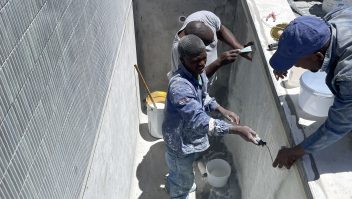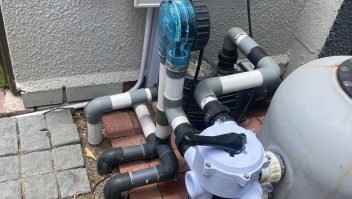Written by Pools Reno – Expert Pool Repairs & Maintenance in Cape Town
If you’ve noticed small, floating bits of white, tissue-like slime in your swimming pool, there’s a strong chance you’re dealing with white water mould. This fungal-like growth often appears alongside pink slime, a reddish bacterial biofilm that’s equally unwelcome.
While it may look harmless, both problems can affect water quality and even cause health concerns. Fortunately, with the right treatment steps and preventive measures, you can restore your pool to crystal-clear perfection.
In this guide, you’ll learn what causes white water mould and pink slime, how to eliminate them using South African pool chemicals, and the best prevention methods to keep them away for good.
Main Takeaways
- White water mould is a fungus-like organism thriving in damp, low-circulation environments.
- Pink slime is an airborne bacterium (not algae) linked to potential skin and urinary tract infections.
- Common causes include blocked filtration, stagnant water, and unbalanced pool chemistry.
- Effective removal involves heavy shock treatment, targeted bacterial cleaners, and thorough scrubbing.
- Prevention requires balanced chemistry, consistent circulation, and regular maintenance.
What is White Water Mould?
One clear sign of white water mould is a shredded-paper-like film drifting on the water’s surface. Scientifically called Oomycota, this organism thrives in areas with poor water movement and high moisture.
Although it may seem minor at first, unchecked mould can quickly spread throughout the plumbing system, skimmer baskets, and filter media. Therefore, complete removal requires an intensive cleaning and chemical treatment plan.
What is Pink Slime in Pools?
Pink slime, or Serratia marcescens, is often mistaken for red or pink algae. In truth, it’s a resilient airborne bacterium that grows in damp, sheltered spots.
Typically, it builds up on pool ladders, inside filters, along grout lines, and in skimmer boxes. Because of its slippery texture and potential health risks, swift and thorough removal is essential.
Causes of White Water Mould and Pink Slime
Several factors contribute to these infestations:
- Poor filtration – Clogged or damaged pumps and filters reduce water movement.
- Weak circulation – Dead spots around steps, corners, and ledges create breeding grounds.
- Unbalanced chemicals – Low sanitiser levels allow bacteria and mould to thrive.
- Biguanide sanitiser misuse – Incorrect maintenance can lead to resistant strains.
How to Get Rid of White Water Mould in a Chlorine Pool
Because white water mould resists standard chlorine levels, a multi-step process is necessary:
- Inspect Pump & Filter – Confirm all equipment is running at peak efficiency.
- Skim the Surface – Use a net to remove visible mould, disposing of it far from the pool.
- Clean the Filter –
- Sand filters: Backwash for at least 3 minutes, then rinse.
- Cartridge filters: Hose down or soak in cleaner.
- DE filters: Wash grids and recharge with new DE.
- Balance Water Chemistry – Adjust pH to 7.2–7.6.
- Shock Dose – Add 350–400 g HTH Granular or Bioguard Burn Out Extreme per 10,000 litres for a triple/quadruple shock.
- Scrub All Surfaces – Focus on ladders, skimmers, steps, and hidden corners.
- Run Filtration for 24 Hours – Keep circulation constant.
- Repeat Brushing & Vacuuming – Vacuum to waste to remove dead material.
- Clean the Filter Again – Remove any trapped spores.
- Re-Test and Adjust – Ensure safe swimming levels before use.
How to Get Rid of Pink Slime in a Chlorine Pool
Pink slime removal is equally intensive:
- Deep Clean the Filter – Use specialised filter cleaner.
- Scrub Surfaces Thoroughly – Pay attention to grout lines, steps, and ladders.
- Balance Water – Maintain pH at 7.2–7.6.
- Stop Pump Temporarily – Allow chemicals to penetrate stagnant water.
- Add a Pink Bacteria Cleaner – Apply quaternary ammonium algaecide (e.g., Blu52) at label dosage for 10,000 litres.
- Shock the Pool – Apply 350–400 g HTH Granular per 10,000 litres; leave for 24 hours.
- Vacuum to Waste & Clean Filter – Removes remaining bacteria.
- Maintain Elevated Chlorine – Keep at 5 ppm for 3–5 days.
Biguanide (Non-Chlorine) Pool Treatment
For biguanide pools, the method changes slightly. Use an oxidising shock like Baquacil Oxidiser at 3 litres per 38,000 litres plus a compatible algaecide. Maintain 50 ppm biguanide for one week before returning to normal.
Prevention Tips for Cape Town & Western Cape Pools
- Keep chlorine at 3 ppm or biguanide at 50 ppm year-round.
- Run pumps for 8–10 hours daily in summer.
- Brush and vacuum every week.
- Clean filters monthly in peak season.
- Improve circulation by adjusting return jets and removing obstructions.
Pools Reno Pro Tip: We offer professional deep cleaning and circulation assessments in Cape Town to stop mould and slime before they start.
FAQ – White Water Mould & Pink Slime
1. Can I swim during an outbreak?
It’s not advised — pink slime is bacterial and may cause infections.
2. Are these algae problems?
No. White water mould is fungal-like; pink slime is bacterial.
3. How long does removal take?
Usually between 2–5 days depending on severity and equipment efficiency.
4. Does routine chlorine prevent these?
Yes, if maintained consistently at proper levels.
5. Who can help in Cape Town?
Visit our Pool Maintenance Services or Contact Us for expert treatment.



